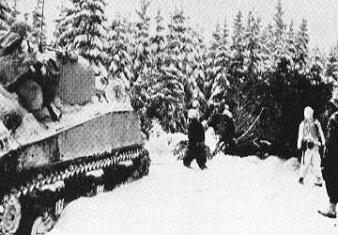Christmas Day, 1944, the 508th PIR was organizing a defensive position along the Basse Bodeux-Erria-Villettes line overlooking the highway to Leige. Christmas Day was neither a day of rest nor joy for the regiment. No presents, even mail. Morale was at its lowest, but one thing was certain - no German would pass the 508th PIR line. There would be no more withdrawals; no more overrunning American units. The German’s attack would be blunted, bent, and broken from this position.
Christmas night the Germans launched an attack against the 508th PIR boundary between the First and Second Battalions. After a furious battle, the Germans withdrew leaving behind many dead and much equipment.
On December 28, the Germans again launched a strong attack against the regiment, in the third battalion area. Fortunately, a battalion of 155 howitzers had been attached to the 508th PIR the morning of December 27. The battalion’s forward observer, in the third battalion area, directed the 155 howitzer's 100-pound shells on the attacking Germans with acc uracy. The attacking Germans withdrew leaving behind almost a hundred dead German soldiers. General Gavin later surmised that this was the German’s final supreme effort to attack down the Leige road.
The First US Army launched an army-wide attack on January 3, 1945, to destroy the "Bulge." The 508th PIR was held in reserve until January 7 when it was ordered to seize the Their-du-Mont ridge from which it had withdrawn on Christmas Eve. The regiment attacked in a column of battalions across deeply snow-covered open terrain, with each battalion pushing through to its own objective. 3, 1945, to destroy the "Bulge." The 508th PIR was held in reserve until January 7 when it was ordered to seize the Their-du-Mont ridge from which it had withdrawn on Christmas Eve. The regiment attacked in a column of battalions across deeply snow-covered open terrain, with each battalion pushing through to its own objective.
The Germans with camouflaged 88mm rifles (high-velocity antiaircraft guns) shrewdly held their fire until the 508th PIR men were within five hundred yards of the guns, and then they methodically destroyed them.
Aware that to stop meant massacre; the 508th PIR men pushed on sustaining heavy casualties. General Gavin said "That's the finest job I've ever had done for me." | 

